Written by Tom Wright - http://life.tomwright.me.uk
For ten years I have ritually travelled the AP7 from Altet airport to Denia and marvelled in awe at the strato-volcanic semblance of Puig Campana - Costa Blanca’s second highest mountain. Rising to 1400m from sea level this giant monolith takes on a more congenial form as the toll road bisects Benidorm’s suburbs, but the vast gully draining into vertical scree appears just as uninviting. A most intimidating proposition and that is where the fascination ended. Besides my true love was Montgó, a little further up the coast.
Then one evening in 2016 I watched the Vuelta tackle the long steep climb to Aitana which, at 1558m, is Costa Blanca’s highest summit. Being only a giant’s stone throw away from Puig (pronounced Putch), the seed of an idea was planted. I googled for a race that might take in both these great summits of the Marina Baixa. There were the relics of a mountain race last run in 2016 and footage of the ISF Vertical Kilometre up aforementioned gully. Finally in early May, as I was feeling the withdrawals from completing Madeira, I stumbled upon Costa Blanca Trails. A new brand and a new race based on what was already well established. No sooner had entries opened I was enrolled. No companions on this trip. A solo adventure into new territory as I would discover how majestic the Costa Blanca truly is for mountain running.
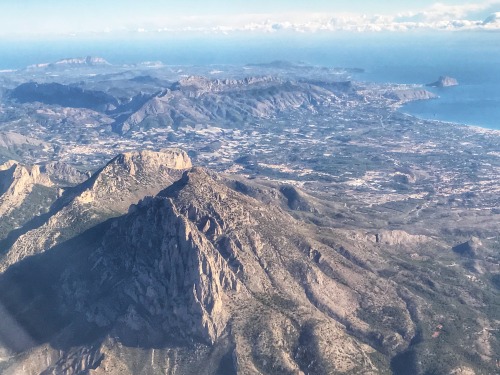
The flight into Alicante offered a bird’s eye view of the three summits I would target over three days - Puig Campana, Bérnia Ridge and in the background Montgó.
Finestrat would be my initial base, and, courtesy of booking.com, Ian and Olwen Reid my adopted parents for the first two nights of a long weekend. I don’t use that word in jest either as they cared for me beyond the call of duty. Ian got up at 5:15am race morning to make me a “breakfast of champions”; they both greeted me at the finish and revitalised me with beer and food at La Barra; drove me back to their wonderful villa nestled in the shadow of Puig itself; and prepared an evening meal - which was foiled with Rioja and highlights of the afternoon’s rugby internationals. The kindest couple and I cannot recommend enough Casa Puig as a base for anyone wanting to explore the mountains around Finestrat.
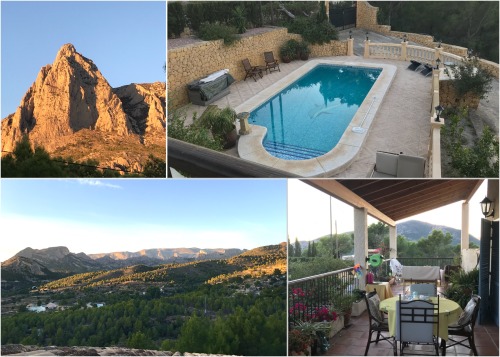
Casa Puig - (from top left) View of Puig Campana from the bedroom window; the swimming pool; the breakfast balcony; Serra Aitana from the balcony.
Anyway to the Costa Blanca Trails. There are four distances to chose from: Trail 18km; Marathon (2850m+); 65km Ultra (4200m+); and 102km Ultra (6500m+).
I chose the entry level ultra at 65km which took in both Puig Campana and Serra Aitana but excluded the Serrella range beyond the Guadalest valley. Reasons being: I was keen to have functioning legs the three days following for further exploration; I had already proved my 100km mettle in Madeira; and ultimately I wanted to see the sun rise from the summit of Puig Campana. Since the 102km started at 11pm it was not an option.
Registration was Friday evening in a small office tucked a short way down one of Finestrat’s narrow alleyways. This allowed me time to share a welcome cerveza in the November sun on Ian’s patio then familiarise myself with the one kilometre track into town, which happened to be the route off the mountain for all races and was already well marked with Scarpa branded orange tape.
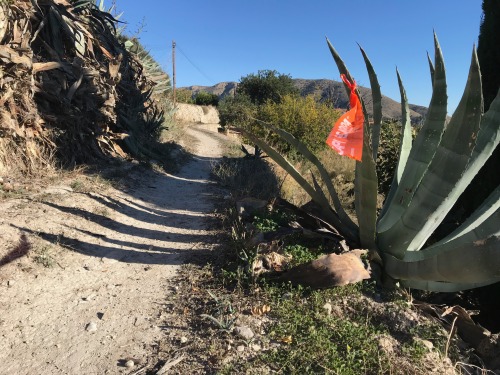
Familiarising myself with the final downhill sprint. Although, with the short autumn days, there was considerable likelihood it would be dark when I came to finish (unless I managed to break twelve hours).
Close to 900 runners had registered for the four races, nearly all Spanish. I was the only Brit in the 65km and only one of a handful of non domestic runners in the entire series of races. I am sure that will change as word the spreads.
The organisers are evidently keen to make this the de-facto event for the area and worthy of holding its own on the grand stage of global ultra running. The goodie bag had all the makings of a major European race. Tee-shirt and socks, both in my preferred tango orange, along with a light beer from subsidiary sponsor, Amstel, and the usual selection of bag tags, number and timing chips were just reward for my 60 euro entry fee. I saw little need to use the bag drop at 45km but decided a bag at the finish would be essential since Spain is “a cold country with a hot sun” (not my words) and sundown was 6pm.
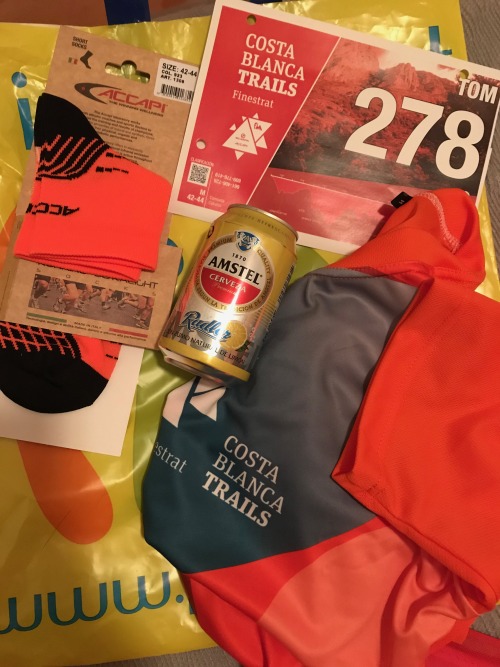
Yes Tango Tom is one happy customer!
Ian is actually a former runner himself having lived and raced in Benidorm and the surrounding area since the 70’s. He clearly understood the need to carb up before a race as he served up yoghurt, raspberries, honey, toast, tea, fruit and sponge cakes for breakfast at 5:30am. I had intended on munching a banana and Gu waffle so this was a most unexpected treat.
I jogged down to the start line just after 6am by the light of my Petzl Nao wrapped in my Montane Prism coat to take away the slight chill in the air. One by one we were marshalled into a caged area via a kit inspection. A happy Spaniard expressed some happy Spanish which I did not understand but suspect was along the lines of -
“you have a very big bag, a lot of water and nothing else”!
Which would be true. Kit list as follows: cup; head torch with spare battery; wind jacket with hood; foil blanket; bag min 3 litre capacity; at least 1 litre of water; emergency food; buff or hat. So not needing the full waterproofs, gloves and spare layers typical of a British race in November I had plenty of space in my 10 litre s-lab pack to add additional water vessels. Two soft flasks up front and a hand held in my kangaroo pouch. Along with quite a selection of Spanish gels, which I had picked up in Consum on our previous visit two weeks earlier, and the aforementioned Gu waffle that was now surplus to breakfast requirements. Learning from my previous experience at MIUT, I had packed away my wind jacket and donned just a mesh vest and arm warmers. This race was only going up so, despite the low air temperature, I expected to break sweat in no time. I also abandoned a tradition of my long distance running… 2XU compresssion and trail shorts. After all this is Spain and the quads deserved a bit of vitamin D!
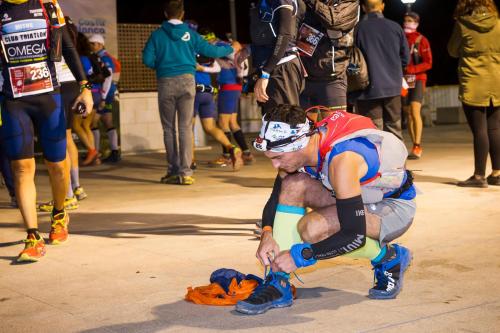
Pre-race lacing - a nervous disposition!
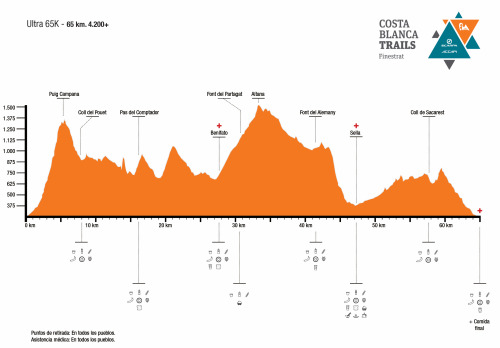
Profile of the Costa Blanca Trails 65km. Two major climbs, the first being a VK; a couple of deceiving climbs in the middle; one very steep descent to Sella; and a 5km downhill finish.
Finally ahead of 6:30am we were marshalled out of the cage and under the starting inflatable. This time I did understand the Spanish as the announcer asked us to move forward as all but the elites hung a comfortable distance back. I had no intention of getting stuck in the usual melée of a European sprint start and nestled near the back casually making my way over the start line following the hooter. As soon as we were away from the crowd of villagers that had awoken early to support us I took to walking the tarmac road out of town.
Is there any point running when you imminently face an ISF VK? Beyond Font del Moli there was even a sign, adorned with ISF logo, heralding the expectant change in gradient. I probably should have taken a photo but feared stopping even for a second may have a drastic knock-on effect on the single file line of traffic that had now formed behind, and ahead of, me. So we would climb 1000m in 3.5km - yes this VK really meant business!
What a way to start a morning’s mountain running on the Costa Blanca!
I had no expectations or plans for the day other than to enjoy myself and discover some new hiking trails that I could return to and expand on in the future. The VK, scree and all, was just a taster of the climbing that lay in store as our route meandered through the Marina Baixa interconnecting a number of cols that allowed as to bisect ridge lines of sharp uninviting pinnacles and tall buttresses of white rock. The tracks a mix of fire road, Mozarabic trail, indiscernible mountain trods and tarmac, led us through olive groves, mountain pastures, rocky boulder fields and several mountain villages. Water and aid stations were well placed along the route although I quickly found myself turning to the gels in my pack for energy as the heat of the sun made dry food unappealing.
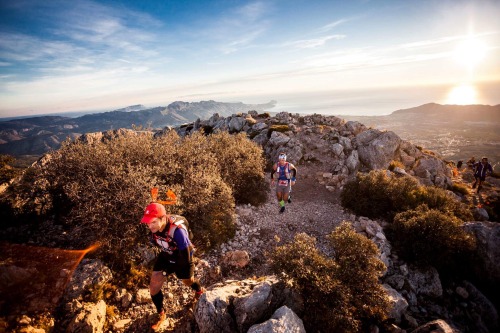
Cresting Puig in the orange glow of a Mediterranean sunrise and the realisation that Benidorm’s skyline is eclipsed by the majestic mountains concealed behind. A just reward for anyone venturing to Puig Campana’s summit. At 1408m, and only ninety minutes into the race I had already climbed higher than The Ben.
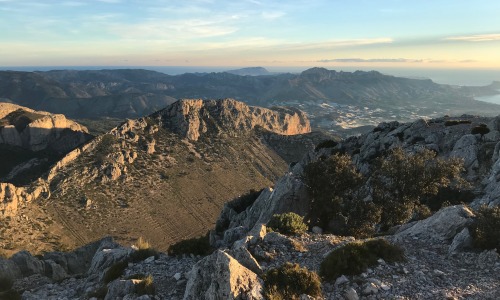
Ponotx’s kinder side, Bérnia and Montgó omnipresent in the background.
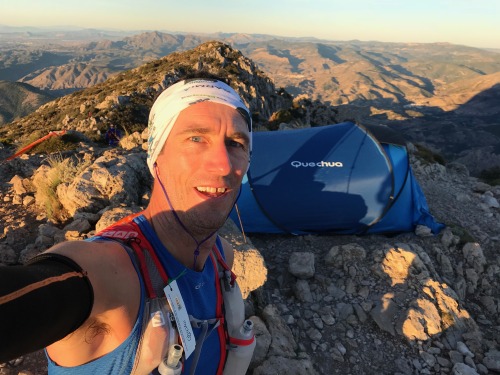
A marshal had been camped out on Puig’s summit since the 100km race had passed through in the early hours.
Puig Campana made excellent work of dispersing the field however I rarely found myself without company and as fate would have it saw the female race unfurl around me as I shared the Penya de Sella ridge with the second lady, who would eventually go on to win, and the long climb back to Puig along the PR-CV 12 with the, then, leading lady. Conversation was sparse as my Spenglish did little but confuse!
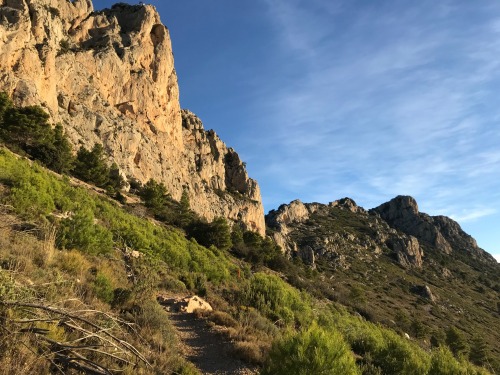
Heading for Col del Llamp below Ponotx’s western ridge.
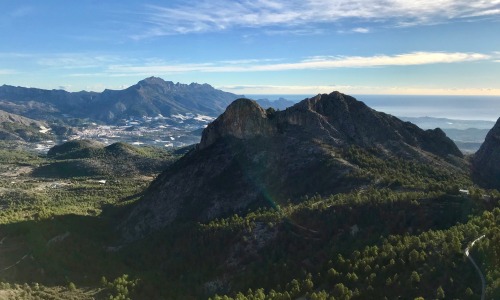
Penyo de Cabal and Bernia
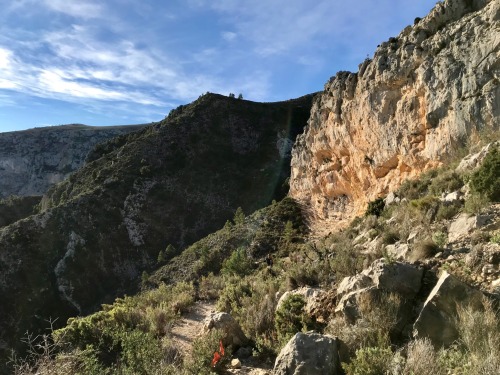
The tall white buttresses …
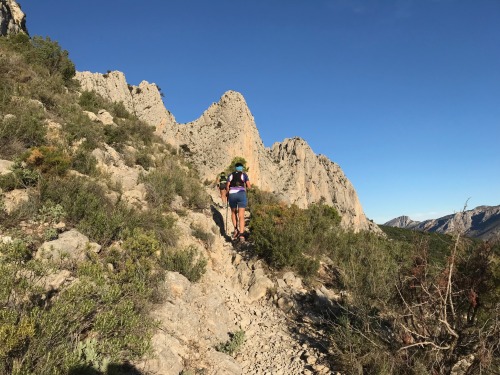
… and jagged pinnacles make up El Carrascal

The view from Port de l’Arc. One of the lesser but none the easier climbs in the middle of the course.
Of course the pinnacle of the day was Aitana. The climb was long and tiresome. Fortunately the aid station, just 2.5km out of Benifato, was complemented further up by fuente’s (water fountain) that offered a refreshing dunk under ice cold runoff. There was always an impressive vista to distract from the exertion with the Bérnia ridge and Montgó omnipresent on the northern horizon. Approaching the false summit of Aitana (the true summit a closed military installation) we passed under the shadow of pine trees. At 5000 feet and with an absence of heat as the winter sun passed too low through the sky the trail was littered with frost. A first for me in Spain!
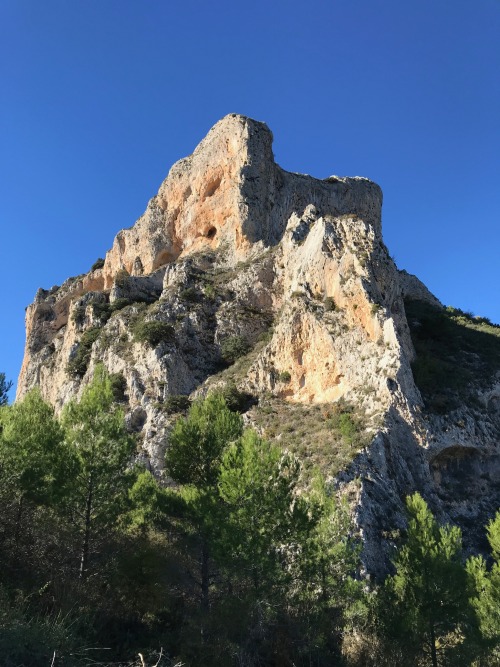
One of the tall pinnacles comprising the Partagat
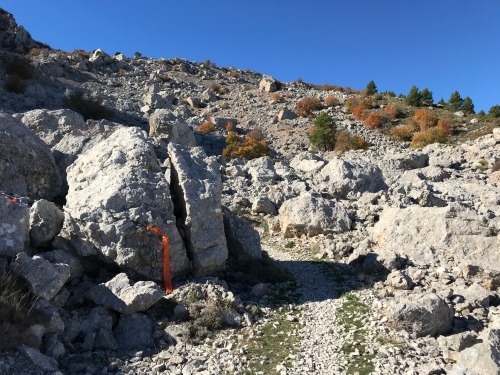
As the climb briefly levelled off the track gave way to boulder fields.
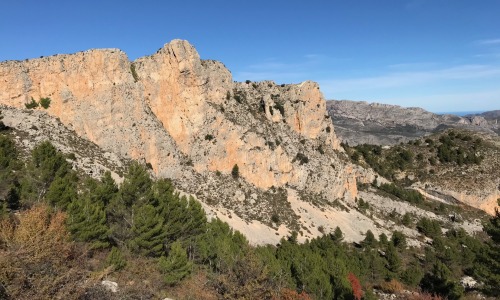
Imposing buttresses on the Partagat looking across to the Serella
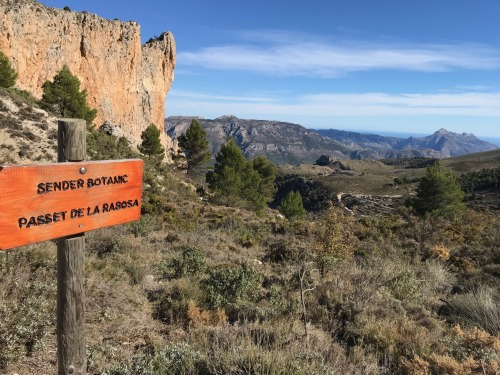
Looking back across the Guadelest valley to Serella and Bernia

The “golf ball” on Aitana’s summit
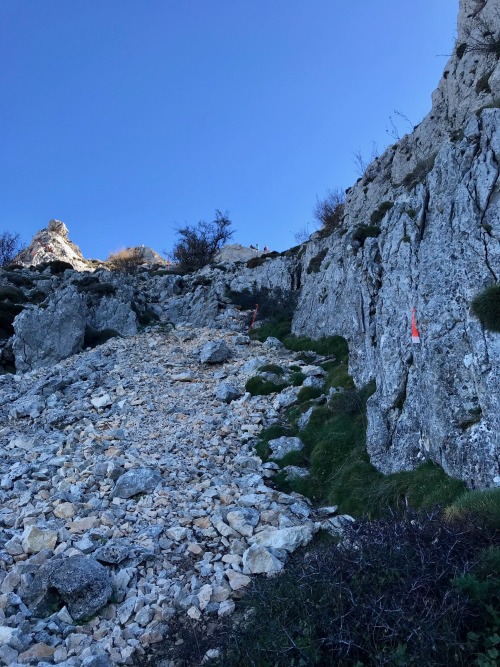
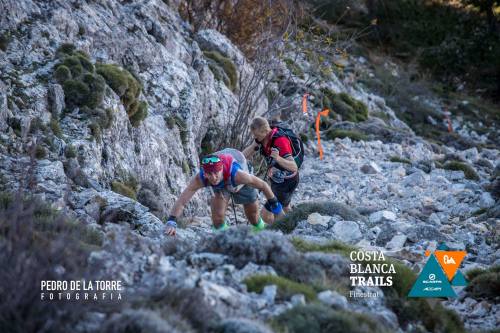
The scree and scramble to Aitana’s summit in the company of one of the two Brits on the 100km course.
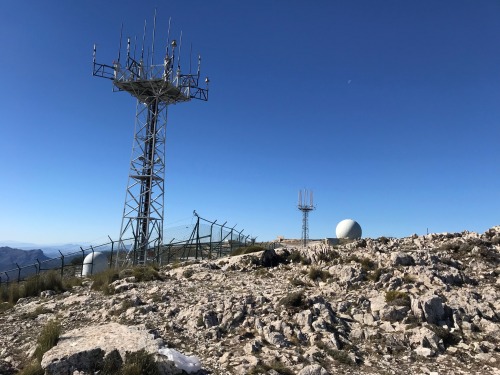

From the summit the view was impressive! Far away across the water we could make out Ibiza (not in the photo though!) while to the north-east Montgó was omnipresent.
The terrain on top was similar to Montgó’s own plateau with a barely discernible path over sharp and jagged limestone rock. I was in my element and once again picking off runners.
The back half of the course was dominated by fire road and long gradual descents/ascents. Which probably explains how I managed for the first time in a race to negative split as my average pace fell from 20 to 15 minute miles. Fortunately the ever changing landscape was a distracting lure from the monotony of the road. It was also broken up by a couple of very exciting descents.
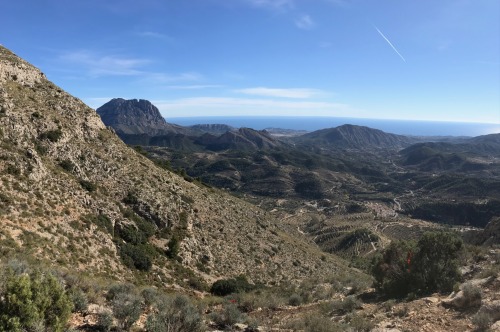
The start of the descent to Sella. Puig in the background.
Of which the barely perceptible track from Coll de Travessa to Sella was the most technical of the entire route with plenty of insecure rock and scree to lose footing on. Ahead of me a runner fell hard on his back. “Estas bien?” I enquired. He did not respond. “Vale?” I tried. Still no response. Third time lucky: “You OK?” “Yeah but this is no fun with 80km in my legs!” It was another Brit, in fact I believe the other Brit of the two that were in the longer race! I had no time to stop and talk. I was putting into practice the techniques and skills I had perfected mastering Montgó’s eastern descent, and again passing numerous runners, as I skied the scree and tip-toed over the jagged limestone. The legs felt good and in no time I had covered the 2000 foot drop into the hot feed station at Sella. My confidence in my descending only grows and as a little race within the race I was stoked to find my way into another Strava top 10 (despite a long overdue toilet stop half way down!)
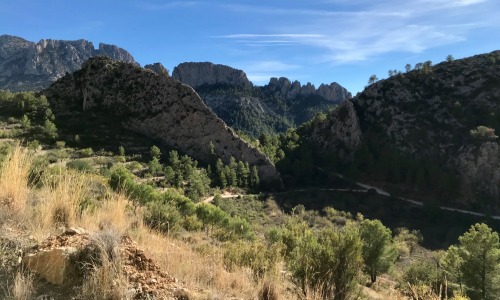
The jagged towers of the Castellets
The dream finish wasn’t to be as, no sooner did I hit the long downhill to Finestrat, I cramped up. The fire roads and the steep switchback ascent onto Puig’s north-western wall had taken its toll and the legs were exhausted. I refused to give up though and following some painful stretching I was able to run the cramp off and maintain enough pace to cross the finish line in under ten hours. A race with no expectations other than to enjoy myself and finish before sundown and I just finished in the top 10 veterans!
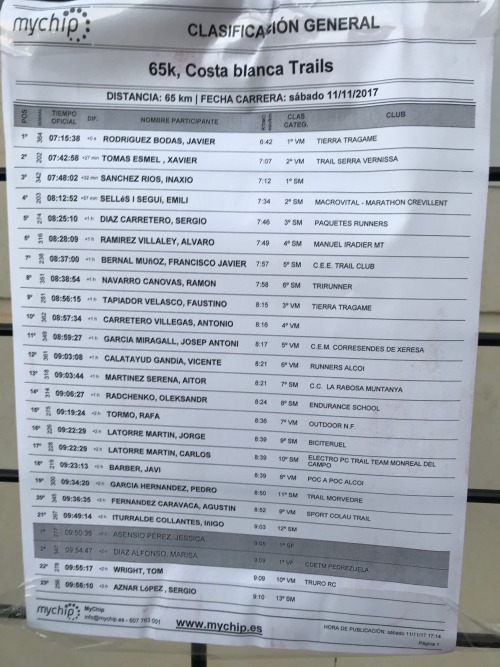
First time my name has made the first sheet at a European mountain race
It was the usual electric atmosphere at the finish with music pumping and Spanish voices filling the air. A vast dish of paella was under constant supervision. I was starving, it was free, so I did not object picking around the large chunks of meat that dominated my plate! Sometimes it helps to be British as the barman saw my needs and kindly gave me a second beer on the house.
Tired, dehydrated and a little deranged how lucky I was to be whisked up by Ian and Olwen for food, more beer and ultimately a long night of sleep ahead of three more days of hiking in the Costa Blanca. Having been in my peripheral vision for much of the day, the Bernia Ridge and Montgó were calling.
I hope the photos and my words have done this event justice as the Costa Blanca Trails is a truly excellent race with challenging climbs and ultimately stunning views. Well worth checking out!

